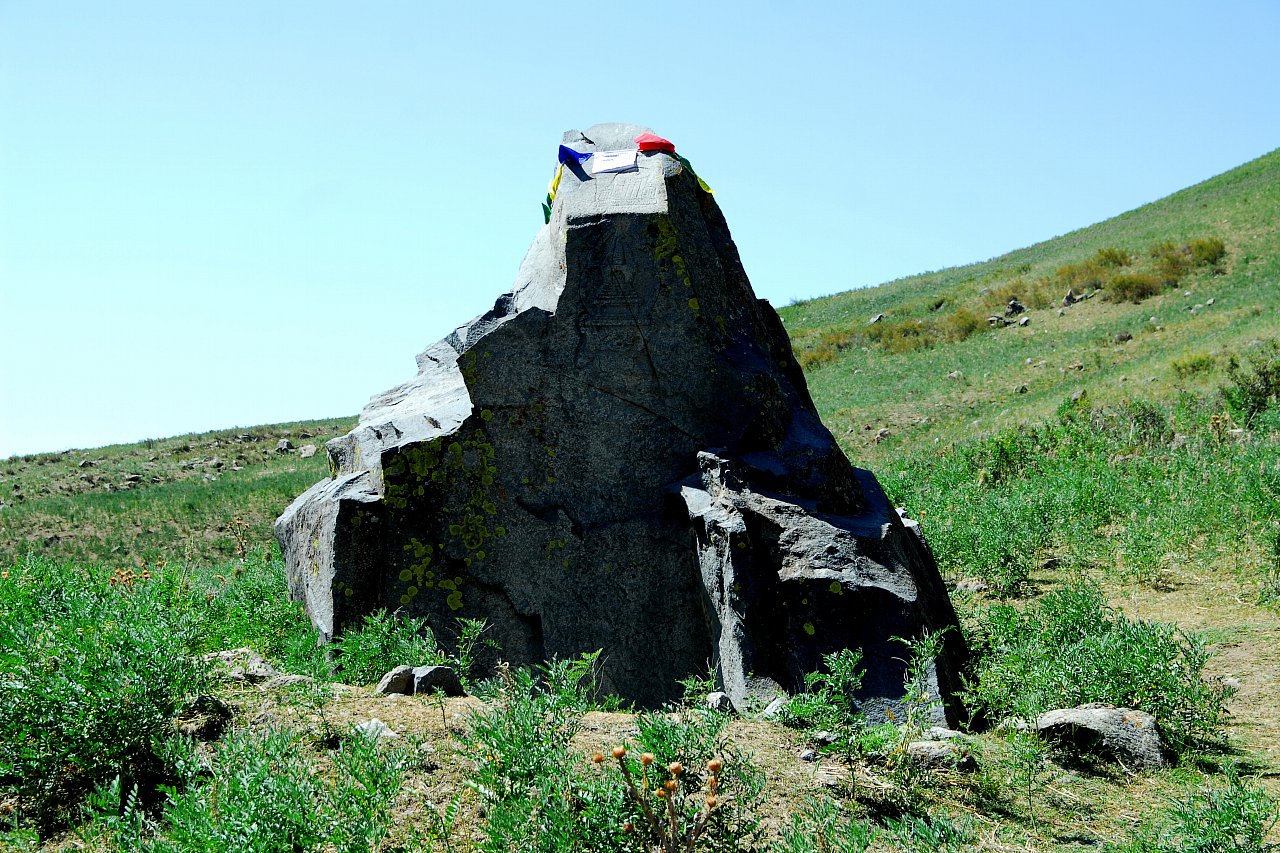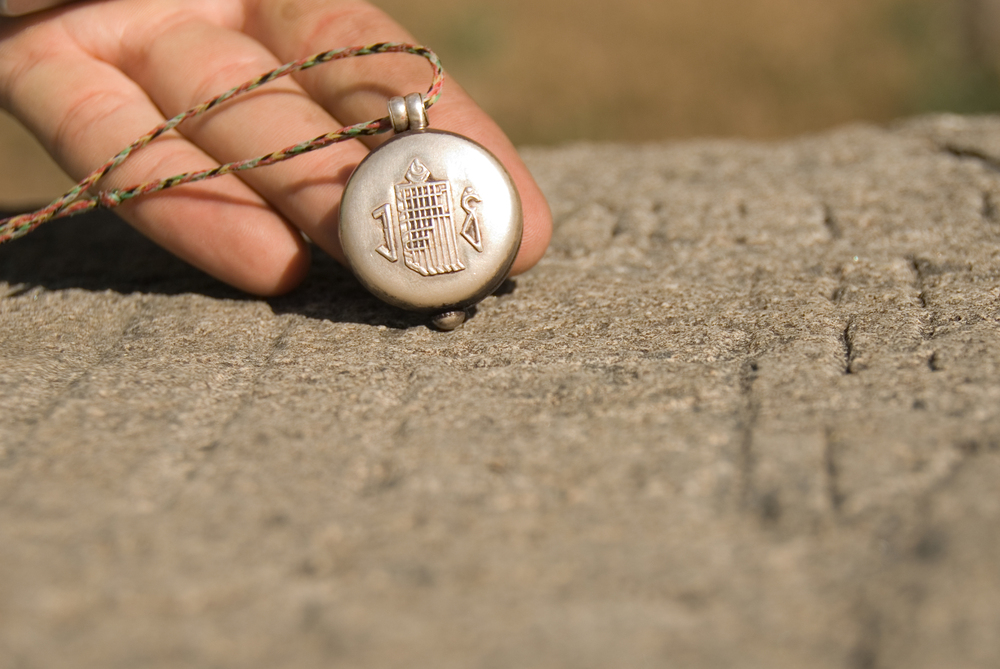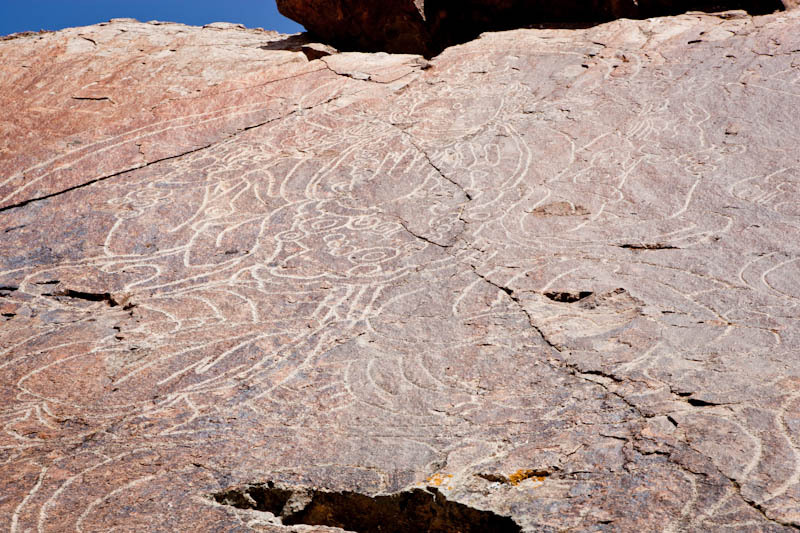Buddha’s Trace on the Silk Road
A stone’s throw away
Many people believe that so called Kapchagai Buddhas is the only Buddhist monument in Semirechye, if not in the whole Kazakhstan. In order to verify these data I went to the Alakol Lake in search of other Buddhist monuments.
I’d like to note that you need to have a car to get there; a full-scale four-wheel drive off-road vehicle would be the ideal choice, because the objects we are going to search for are located far from the main roads and any infrastructure objects. There were arranged access roads to Tamgaly Tas, meanwhile the way to the Buddhist territory goes through a gate informing that you are in the right location.
So our three cars set off to Taldy-Korgan by Almaty-Oskemen motorway (motorway A350).

The first location on the route was the city of Tekeli located 40 km eastward of the regional center Taldy-Korgan. Local residents willingly provide us with information about location of the stela. All of them believe that it is a Buddhist monument. We found the stela in the valley of the Kora River, eastward of the city. It’s interesting that the word «kora» is translated from Tibetan as «ritual walking around Buddhist shrine», and in fact we found a well beaten path around the stela.
The Tekeli Stela is a three meters high rock looking like a pyramid. There are engraved images on it, which are seen clearly: a Stupa representing Buddha’s Mind, a Snow Lion holding the Stupa in his paws (Snow Lion is considered in Tibet to be the bravest and the most honest animal), symbol of Kalachakra and his mantra (Kalachakra doctrine is closely connected with the legend about the hidden kingdom of Shambhala where it is believed to be practiced at the national level. According to Kalachakra’s prophesies the kings of Shambhala will interfere in the world affairs when the forces of darkness, aggression and ignorance pose a threat to existence of the civilization) and on the top there is Kalachakra’s seed syllable or monogram called «The Ten Mighty Letters» symbolizing the ten aspects of Kalachakra’s mandala (universe).
After that we went to Kailyk village via Taldy-Korgan, Zhansugurov and Sarkan. The village is identified by historians as the medieval settlement Kayalyk. As a result of numerous archaeological excavations, carried out in the territory of the village and its outskirts since the Soviet times, there were found ruins of Christian, Muslim and Buddhist religious structures, being indicative of tolerance (as early as that time!) of the citizens of the medieval settlement and influence of various cultures.

We were interested in the preserved ruins of a Buddhist temple, which was built in an open area from mudbricks. All of a sudden one of our regional ethnographers has a sense of déjà vu. He remembered how this temple was looking, although he had never been to that place or seen the temple.
We spent night near the temple on the bank of the Lepsy River. By the next midday we arrived at the Alakol Lake — not bad finishing point for the tour of the places connected with the name of Buddha…
Background
How Buddhism was spread in the territory of Kazakhstan

The first stage
Buddhism was brought to Kazakhstan from India and China. This process was started in the middle of the I century before the common era. An important role in spread of Buddhism in the Central Asia, East Turkestan and China was plaid by Central Asian theologians and missionaries, in particular Parthians, Yuezhi, Kangju and Sogdians, who especially actively preached the Buddha’s teaching in the II-III centuries of the common era, which was connected with particular purposes of the Kushan empire in the East.
 The second stage
The second stage
Impact of Buddhism on Turkic peoples is confirmed by Xuan Zang, who wrote about Turkic peoples’ amicability towards this religion of the eastern Turkic chagan. In the first half of the VII century particular western Turkic rulers became Buddhists or Buddhism protectors. Turcologist A. Gaben believes this fact to be connected with Turkic peoples’ transition to the settled and urban living.
This process was rather intensive in Semirechye being the domain of the western Turkic peoples, Turgesh and Karlouks, which is confirmed by temples, monasteries, chapels, as well as statuettes and stelas bearing Buddhist images, which were found in the territory of ancient settlements in Chu Valley (Ak-Beshim, Krasnaya Rechka, Novopokrovskoye).
Buddhism was distributed in Semirechye after the X-XI centuries as well. Guillaume Rubrouck, who was the ambassador of the king Louis IX to Mongolian khan Munke in the middle of the XIII century, reported about Buddhist temples in the north-eastern Zhetysu.

In 1253 Guillaume Rubrouck left Lion, passed southern Russian and Kazakh steppes, arrived at the South Kazakhstan and then Semirechye. He stayed for two weeks in Kayalyk city in Zhetysu, which is identified as Antonovka settlement, located in the valley of the Lepsy River, where he saw a Buddhist temple, described by him later.
Distribution of Buddhism in Semirechye in that period was connected with invasion of Naimans headed by Kuchluk. Later Naimans became one of the most numerous clans of the Middle Zhuz. Murza Mukhammed Dulati in his Tarih i Rashidi described violent conflicts between Kuchluk and Kara-Khitai Gurkhan, where the first was the winner. Kuchluk occupied Kashgar and Hotan, his tribes inhabited Emil and Kayalyk. The temple in Kayalyk was built probably in the XIII century.
The third stage
The next third stage of development of Buddhism in Kazakhstan is connected with impact of western Mongoloan tribes Oirats (Kalmyks). Kalmyks- lamaists built temples and monasteries in Kazakhstan. Among them are such monasteries as Ablaikit monastery located near Ust-Kamenogorsk at the foothills of the Kalbinsky Range in the East Kazakhstan and Kzylkent located in the mountains not far from Karkaralinsk.
The Tekeli stela also dates back to the third stage of spread of Buddhism in Kazakhstan.
Buddhist temples were built in Semirechye as well. For example on the map of Dzungaria, drawn up in 1716-1733, there are 85 lamaist temples and monasteries. The map was initially drawn up in late XVII and early XVIII centuries by Jesuits in the court of Qing emperor Kansi, and amended later by Swede Renat, who was captured by Kalmyks.
Petroglyphs showing Buddha and Tibetan inscription are also connected with Lamaism or more exactly Vajrayana Buddhism (Tibetan Buddhism). One of the most famous petroglyphs named Tamgaly-Tas is located in Kapchagai Gorge on the bank of the Ili River. In this place there was a ferry where the Silk Road crossed the Ili River. It is said that in the X century a Buddhist mission heading for Semirechye stopped on the bank of the Ili River. At that time earthquake occurred and a huge stone broke off the rock. The Buddhists understood that to be a sign saying that that was time to go back to India. But before going back they engraved three images of Buddha: Buddha Shakyamuni in the moment of achieving enlightenment, Sympathetic Bodhisatva «Loving Eyes» and Medicine Buddha. Apart from them there are engraved mantras in the Tibetan language.

In 1863 Dungans raising religious slogan of battle for Islam broke out an anti-Chinese rebellion. Soon the rebellion was spilt over to Dzhungaria. Active participants in it were the Uigurs from Kulginsky region. In 1864 the whole Eastern Turkestan was involved in the rebellion. Qing garrisons, fortresses and settlements were destroyed, as well as Buddhist temples and monasteries. One of those destroyed monasteries was Sumbe monastery, located 320 km eastward of Almaty, which was described by Chokan Valikhanov as early as 1854.
1864 was the last year of Buddhism existence in Semirechye. However Buddhist heritage is still preserved in archeological monuments.